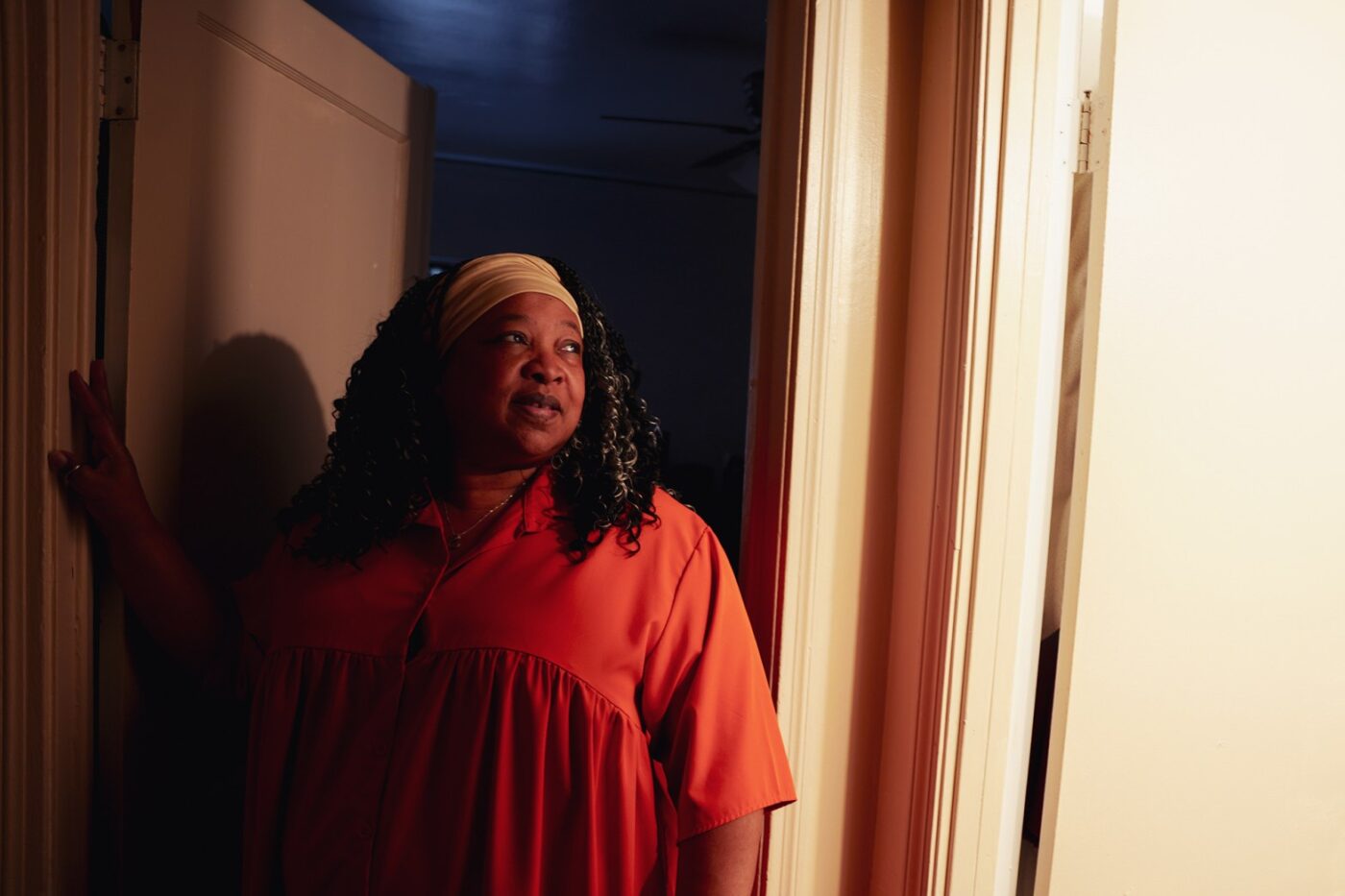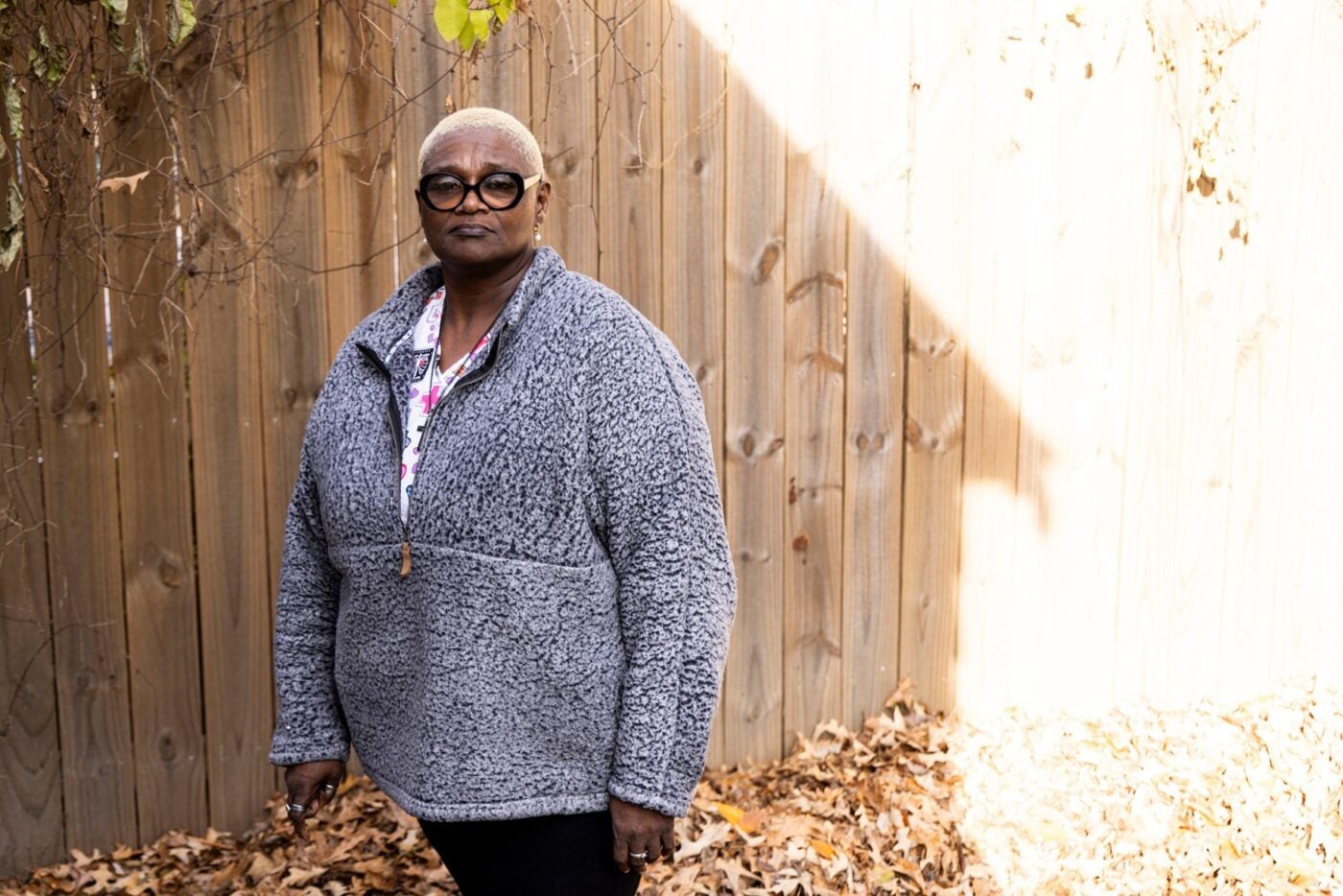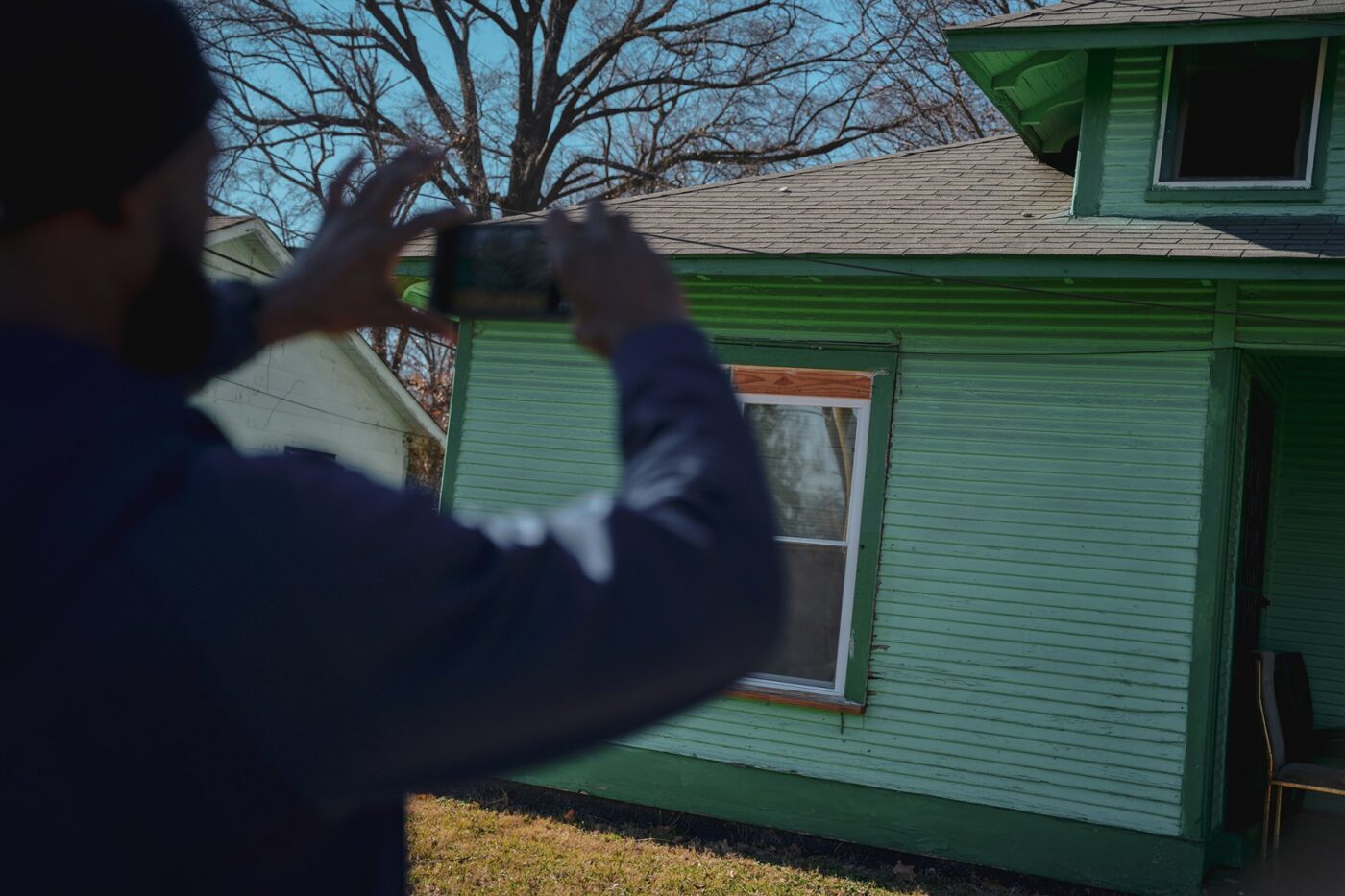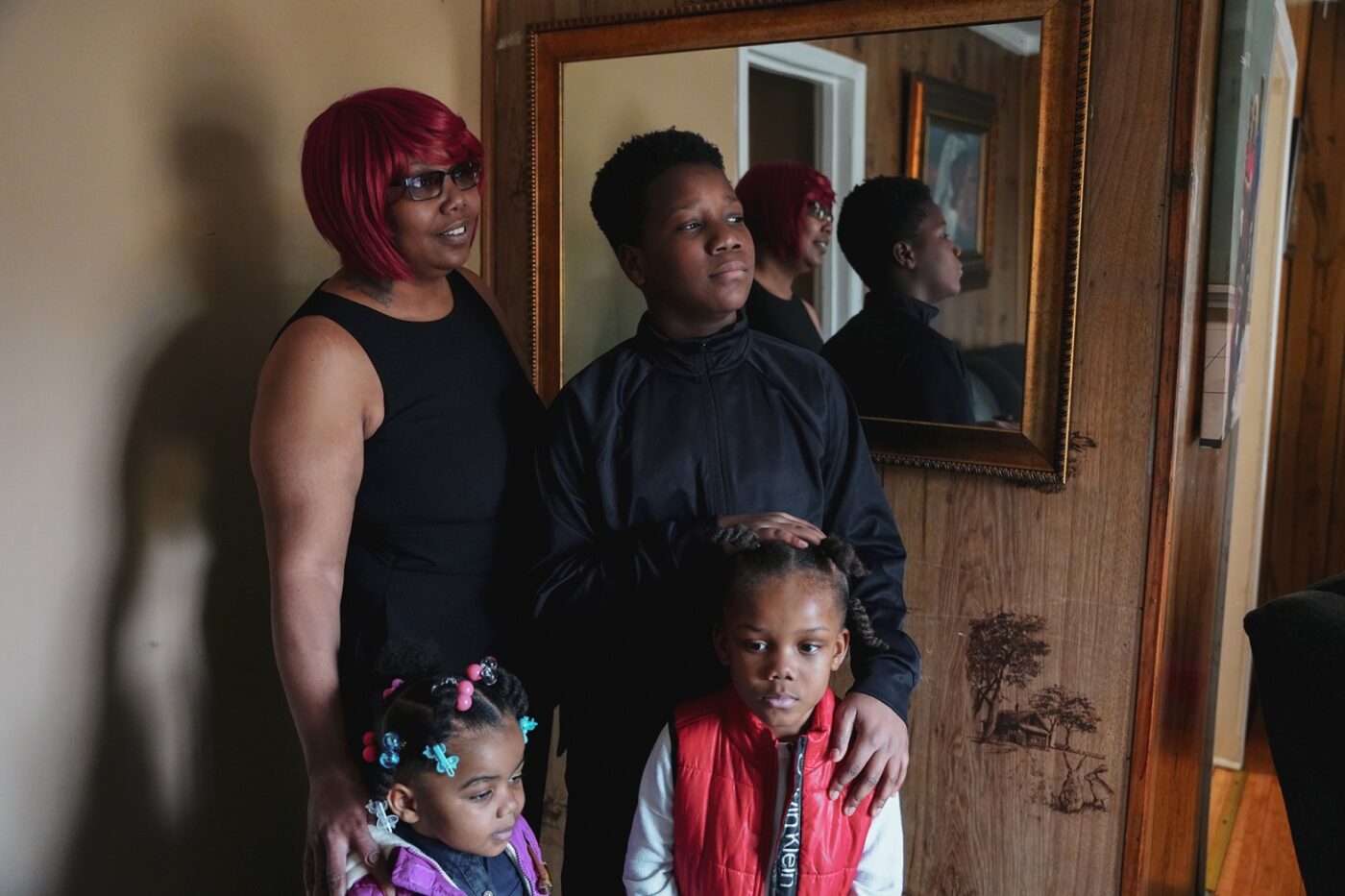
Feature
Lead makes people sick. So why do Memphis leaders overlook it?
This story was originally published by MLK50: Justice Through Journalism as the first in a series on lead poisoning. Read the other stories here and here, and subscribe to MLK50’s newsletter here.
After Denedra Levy and her family moved to South Memphis, Tennessee in 2022, her two-year-old daughter and four-year-old son kept getting sick—vomiting, loss of appetite and headaches.
One October morning, she and the two children took the bus to their pediatrician’s office. There, the doctor decided to test the kids’ blood lead levels. Levy thought little of it; they’d been tested before and were fine. But the doctor returned with bad news: Her kids had ingested an alarming amount of lead.
Levy’s mind raced. She thought of the water crisis in Flint, Michigan and the news reports about the affected kids. She asked the doctor if she could prescribe medicine, only to be told there was none.
The pediatrician started to explain the toxin’s long-term effects and told her to move from her aging rental home. Immediately.
“It hurt because [my kids] are all I got,” Levy said. “I cried.”
In 2023, 389 kids in Tennessee’s Shelby County tested positive for lead poisoning, according to state data, which is likely a significant undercount since only 17 percent of young children were tested. Most of these kids live in the city’s older, lower-income neighborhoods, and they ingested lead primarily through dust in their homes and yards, from old lead paint, and other sources.
Because most lead-poisoned children don’t have levels high enough to cause immediate health issues, elevated levels often go unnoticed, undiagnosed, and untreated. But the consequences are lifelong.
The research is clear: Lead can throw children’s brains off track, especially children under 6. Kids who have elevated levels of lead in early childhood perform worse in school than their peers and face a higher risk of developmental disabilities, mental illnesses and, later in life, cardiovascular disease. The toxin also weakens the brain’s ability to control impulses. Without that internal safeguard, lead-poisoned kids can be more prone to commit crimes when they reach adulthood.
Lead poisoning undermines local efforts to improve education, health, and public safety—some of the most critical issues facing Shelby County. But local leaders invest little attention and few local dollars to address the crisis, though doing so has proven cost-effective elsewhere. Faced with understaffing and pandemic-era disruptions, the City of Memphis and Shelby County’s federally funded efforts to remove lead from homes and test kids’ blood are slumping. In 2018, the city and county removed lead hazards from more than 150 homes. In 2023, that number was 67.
Tavita Conway, who runs the city’s program, told MLK50: Justice Through Journalism that her team has long struggled with insufficient public awareness, funding and assistance from other parts of local government. Forced to focus on the federal grants’ specific, short-term requirements, her team didn’t stand a chance of systematically addressing the public health crisis posed by lead even before the pandemic impeded them.
“We’re putting Band-Aids on,” she said. “It’s certainly frustrating. … I feel responsible for every child.
“There’s no reason someone should be lead-poisoned in this day and time.”
Sign up for Harvard Public Health
Delivered to your inbox weekly.
Lower test scores, fewer graduations
Levy’s youngest son, now five, loves Power Rangers—especially the red and blue ones. He likes singing Cocomelon songs. And he really enjoys school.
Unfortunately, learning is not his strong suit, his mom said. He struggled to pay attention when she taught him shapes and colors. He doesn’t seem to have a major developmental delay—as extreme lead poisoning can cause—but she’s confident lead altered his brain.
Students with elevated levels of lead are more frequently diagnosed with intellectual disabilities or labeled “substantially below proficient” at school. And the toxin accounts for part of the Black-White test score gap because Black kids are more likely to live in old homes.

A team walks through Mallory Heights while canvassing with the nonprofit organization Young, Gifted and Green in January to help people learn about testing their homes for lead.
Photo by Andrea Morales for MLK50
Homes built before 1978—which is more than half of Memphis homes—may contain lead paint. Old homes are also more likely to be serviced by leaded water lines or sit near highways, where more leaded gasoline seeped into yards before the U.S. phased it out, starting in the 1970s.
While lead affects a child’s entire brain, it most damages the part responsible for impulse control and attention, leaving affected children more likely to engage in risky, aggressive or disruptive behavior. Because of this, American University professor Claudia Persico and a pair of other researchers studied whether lead in North Carolina students hindered not just those kids’ education but that of their peers.
The results shocked them: 99 percent of the state’s middle school students had at least one child in their grade with a high blood lead level. The lead-poisoned children’s lack of impulse control appeared to both distract and rub off on their peers. The number of such kids in a given school significantly impacted whether their classmates would be suspended, graduate from high school, and attend college.
In fact, a student’s chance of graduating is much more closely tied to the number of lead-exposed students in their school than to the number of low-income students there, Persico said.
“Lead poisoning harms everyone’s children because pretty much all kids go to school with kids that are lead-exposed,” Persico said. “It’s one of those things that is secretly a really huge problem that we sort of overlook and pretend is not really a big deal.”
Only about 15 percent of Memphis-Shelby County Schools students met or exceeded state expectations in math in 2023, and almost 19 percent of local seniors didn’t graduate last year.
A spokeswoman for MSCS told MLK50 that the district takes lead seriously. It regularly tests its water sources for lead and remediates lead paint hazards, and it sees the toxin as one of the reasons it needs more funding to replace and renovate aging buildings. Asked whether lead weighs down county test scores, she said, “research specifically examining the relationship between lead exposure … and local test scores countywide could provide valuable insights.”
Anita Tate, who runs the Shelby County Lead Hazard Control Program, said she doesn’t see local schools connecting the dots between lead and education or doing enough to raise awareness.
When she had a free day in the summer of 2022, she drove to a few elementary schools surrounded by old homes. At each, the receptionists told Tate she couldn’t meet with the principals but could leave her information.
None ever called or emailed.
“People don’t really take [me] seriously,” Tate said.
A major health risk ignored by too many doctors
Charlotte Brown, 62, knew nothing about lead when she reached out to the Shelby County Lead Hazard Control Program in the spring of 2022; she’d just heard the program may help renovate her 1943 house in South Memphis.
She’d grown up in the single-story home and returned in 2014 to care for her brother, who required dialysis, and her mother. The former died in the middle bedroom in 2017, and the latter passed away in the back bedroom in 2018.

Charlotte Brown stands for a portrait at her South Memphis home, which has long been the hub for her extended family. In 2022, inspectors found lead in the window sills, door frames, and plumbing that may have been harming her family for decades.
Photo by Andrea Morales for MLK50
Through those hard years, the home remained the hub for her extended family and a place full of love, she said. But it also fell into disrepair; the old paint peeled off the wooden exterior and littered the yard.
When county lead inspectors arrived at the end of 2022, they found lead in the old exterior paint, as well as in the window sills, the door frames, and the water.
When the officials told her they’d conduct thousands of dollars of repairs, she was thrilled; it was a huge answer to prayer. But the more she learned about the toxin, the more she thought about her grandchildren, who visited the house most days, and her deceased brother.
She remembered watching the grandchildren—now five and nine—crawl around the home and put everything they found in their mouths. And she recalled one incident where they were playing with the paint chips—loading them into their Tonka dump truck and rolling them down the driveway.
She wondered if the toxin was to blame for her brother’s kidney failure in his early 40s or her nine-year-old grandson’s developmental delays.
Experts say it’s almost impossible to tell whether lead has caused a specific health issue versus the many other factors at play in someone’s life. But Brown’s suspicion that lead could have harmed her loved ones is backed up by extensive research.
Children with high blood lead levels are at an 11 percent higher risk of developmental delays like Brown’s grandson’s, according to a 2017 study published in the Journal of Public Health Management and Practice. And studies have shown lead exposure can damage victims’ kidneys.
Elevated levels also put people in greater jeopardy for anemia, high blood pressure, and liver problems. One recent study found that each little bit of extra lead in someone’s body—even at levels below the federal threshold—places them in more danger of suffering from heart disease, which is the country’s leading cause of death. Given all the ways that lead affects health, the study estimates the toxin causes more than 400,000 U.S. deaths each year.
U.S. children have far less lead in their blood than in the 1960s, as removing lead from paint and gasoline made the country a far healthier place. However, the decline also allowed the toxin to fade into obscurity, which worries experts since so many kids are still lead poisoned each year.
Tate said the public’s lack of awareness hamstrings her organization’s efforts to protect children.
“Nobody’s talking about it,” Tate said.
Even pediatricians have become less alert to lead’s threat, meaning they test far fewer children than they should, according to Michelle Miller, deputy director of the U.S. Department of Housing and Urban Development’s Office of Lead Hazard Control and Healthy Homes.
“We’ve often heard [from doctors], ‘Well, they took the lead out of paint in 1978, so that shouldn’t be a problem anymore,’” Miller said. “They don’t always think about how many older housing units still exist.”
Sharon Hyde, manager of the Green & Healthy Homes Initiative’s anti-lead efforts in Shelby County, said many local pediatricians will conduct lead tests only if the parents request it or as part of TennCare’s required testing of one- and two-year-olds. Few children between the ages of three and five are tested, even though they’re still young enough for lead to significantly damage their brains.
“The pediatricians still don’t really grasp the severity of it,” Hyde said.
A contributor to crime overlooked by public safety leaders
Shortly after Kim Byrd’s son learned to walk, officials informed her there was exposed lead paint in her since-shuttered apartment complex, Hurt Village, which was run by the Memphis Housing Authority.
They asked to test her young son’s blood and found a dangerously high level of lead.

Kim Byrd at her South Memphis home. Byrd’s adult son struggles with serious emotional and cognitive challenges, likely caused in part by the lead he ingested as a child.
Photo by Brad Vest for MLK50
In the following years, her son was slow to talk and walk and didn’t do particularly well in school but didn’t require special education. The effects seemed relatively mild until a few years ago, when he entered his mid-20s.
He began talking to himself and having fits of rage. He punched holes in his mother’s walls, broke her bathroom mirror, and shoved her to the floor. He lost job after job for outbursts.
“It’s sad to just think how [Memphis Housing Authority] could just treat people like that,” she said. “[Now], I’ve got to take care of my grown son.”
Aaron Reuben, a clinical psychology researcher at Duke University, said it’s likely lead poisoning helped cause or exacerbated Byrd’s son’s mental illness. While most kids exposed to lead don’t develop mental health issues, the toxin makes the brain more susceptible to ailments such as depression, schizophrenia, and psychopathy.
Whether by first causing a mental illness or simply by damaging the part of the brain responsible for self-control, researchers said it’s easy to see how lead poisoning can lead to criminal behavior.
“It’s very well established that lead is a neurotoxin and affects … a part of the brain that’s extremely important for behavior and things like impulse control,” said Kevin Schnepel, an economist studying crime at Canada’s Simon Fraser University. “When we think about violent crime in particular, oftentimes it is [being unable to control a] response to some sort of emotional cue or shock.”
A 2022 meta analysis of about 30 studies found that declining exposures to lead probably accounted for roughly 15 percent of America’s decline in homicides from 1989 to 2014. One recent study found that a moderate increase in a kid’s blood lead level corresponds with a five percent higher likelihood of committing a crime, and another one found exposures to lead place boys at an almost 60 percent higher probability of facing juvenile detention.
Memphis broke its all-time homicide record last year with nearly 400 killings. When it comes to crime, local leaders—including the Memphis Shelby County Crime Commission and local politicians—have blamed everything from the court system to the new district attorney to a shortage of male role models.
But even though a large body of research proves lead exposure increases crime, local lead experts say their work isn’t taken seriously as a public safety solution.
Tate is trying to change this. In 2022, she compiled a bundle of research and mailed it to the Memphis Shelby County Crime Commission, pleading with them to meet with her. She never heard back. Crime Commission president Bill Gibbons told MLK50 he doesn’t remember receiving it.
Tate also used her free time one Saturday in 2022 to attend a public safety forum that Memphis Police Chief Cerelyn “C.J.” Davis attended. She asked Davis if she’d considered the role lead could be playing in the city’s crime problems.
Davis brushed the question off.
MPD spokesman Lieutenant Bill Kaiser told MLK50 the police department is “unaware of any research conducted by either the Centers for Disease Control or the Environmental Protection Agency concerning a link between lead poisoning and the crime that occurs within the city of Memphis. Therefore, Chief Davis would be unable to give an informed response.”
Although there don’t seem to be specific studies that examine the link between lead and crime in Memphis, the CDC does link criminal behavior to lead exposure. And because the issue has been studied in numerous ways and places, researchers consider lead’s connection to crime to be settled science.
Solutions are cost-effective, see little investment
The City of Memphis and Shelby County invest little in their anti-lead efforts, especially compared to spending on police and schools—which make up the largest line items in the city and county budgets.
The city-owned utility Memphis Gas Light and Water Division is in the midst of replacing lead water lines—primarily using federal dollars—but advocates are frustrated by the utility’s pace. And, research shows that while lead water lines endanger children—especially infants drinking formula—they do not appear as harmful as lead paint.

A crew for Memphis Light Gas & Water Division works on replacing the lead pipes running under Lauderdale Avenue in South Memphis.
Photo by Andrea Morales for MLK50
Both the city and county lead paint remediation programs run exclusively off of HUD grants, with no local or state dollars. They each receive about $1.4 million annually in lead-specific grants and other HUD funding. (By comparison, the city spends about $63 million per year on parks and libraries.)
The city and county programs employ fewer than 10 people combined. Separately, the Shelby County Health Department has just four full-time employees committed to the issue, responsible for increasing testing among the county’s more than 70,000 kids under 6.
Each of these small teams was hit hard by pandemic-era disruptions.
During the height of COVID-19, the programs didn’t send employees or contractors into people’s homes, and testing by both the health department and pediatricians fell off a cliff. Lead removal specialists who the programs had partnered with for years left for other government programs or private opportunities. Some never returned, especially because the lead removal program requires burdensome oversight and regulations that most construction companies don’t want to deal with.
In her role with HUD, Miller watched this same tragedy play out across the country. She said her team is trying to help local governments recruit new construction workers but has struggled, mainly because in a strong post-COVID economy, these workers remain in high demand.
For Tate’s program, the pandemic compounded problems stemming from a regrettable decision in 2019 when county officials decided to close the program. Though they quickly reversed course, the county had to start from scratch and hire a new team, which took until November 2020.
In the last couple of years, the lead paint removal programs have slowly been growing the number of homes they remediate each year. And Conway and Tate hope they’ll be able to return to pre-pandemic levels soon.
Conway would love to invest more in advertising, but money is tight since HUD requires almost all of the grant funds to be spent remediating homes. She’s been pushing for some city funds to help cover costs the HUD grants won’t, but isn’t sure she’ll get them.
But even if her program reaches pre-COVID levels, Conway said it won’t be nearly enough to protect the city’s children. To accomplish that, Conway said her team needs help from across the community.
Like Tate, she’d love help from local schools. Additionally, she’d love to enlist City of Memphis Code Enforcement officers, who aren’t currently trained to look for lead paint or refer properties to Conway’s program. While code enforcement administrators have expressed a desire to help, they’ve told her they don’t have enough funding to take on this extra responsibility.

Randall Marshall takes a photo of a Mallory Heights home while canvassing with the nonprofit organization Young, Gifted and Green. The group's goal that day was to educate the South Memphis community about testing their homes for lead.
Photo by Andrea Morales for MLK50
The pandemic also affected the number of kids being tested for lead—though it had been falling since 2016 when almost 18,000 of the county’s children under 6 were tested. Since 2021, fewer than 13,000 local kids have been screened each year—or about 17 percent of the county’s kids under 6.
However, some help is on the way. The county health department recently received a new HUD grant—$1.5 million over four years—designated primarily for lead testing. With it, the department’s lead team will add employees and purchase a mobile testing facility, which they’ll take to health fairs and children’s homes.
“This is a huge step for us,” said Kasia Smith-Alexander, the administrator in charge of the department’s lead testing program.
Other than through increased funding, far more Shelby County kids would be tested if Tennessee required kids to be tested, as do 10 states, including Louisiana, Iowa, and Massachusetts. In those states, about 30 percent of kids under six are tested each year, according to a 2017 report.
Catching lead poisoning through testing greatly improves children’s life outcomes, according to a 2018 study by Schnepel and a colleague. When tests reveal elevated blood lead levels, parents are encouraged to feed their kids low-fat, low-calorie diets that have been proven to help and are connected with lead paint remediation programs or encouraged to move. The study found these steps put children such as Levy’s at a far lower risk of facing lead-induced problems than kids whose lead poisoning went undetected.
Schnepel’s is one of many studies that have proven investments in lead testing and prevention to be quite cost-effective.
The remediation of lead from a home costs an average of $8,200, Conway said. Meanwhile, lead exposure reduces a child’s average lifetime earnings by about $7,000 and increases their expected lifetime medical costs by about $32,000, according to research by an Amherst College economist. In addition, each lead-poisoned kid reduces their classmates’ combined lifetime earnings by more than $15,000, according to Persico’s research.
“[Investing in lead programs] is almost like a no-brainer,” Schnepel said. “It’s money that’s well spent.”
Recovering and spreading awareness
Levy worries more about her kids than she once did.
The lead has heightened her normal maternal anxiety with each new health issue. She has studied the ways lead could harm her kids, and she’s struggled to cope with what she’s learned.

Denedra Levy and three of her children stand for a portrait in their new home. The youngest two were diagnosed with elevated blood lead levels in 2022.
Photo by Andrea Morales for MLK50
The experience has forced her to her knees in prayer more than once.
“If you don’t have faith, you’re not going to make it out here,” she said. “You got to stay prayed up.”
But Levy also knows she’s somewhat lucky. Her family lived in the home that almost certainly poisoned her children for less than a year before they were diagnosed. If their doctor hadn’t thought to test—as is all too common—the family could have lived there far longer, which would have put the kids at a far greater risk of facing lead’s harshest effects.
Levy said she’s never recovered financially from having to leave the South Memphis house in a hurry and living with friends and families for three months.
But she’s also extremely grateful for the home she found. Tucked into a quiet, low-crime corner of western Frayser, the 1948 home is owned by a highly responsive landlord and features new carpet alongside well-maintained wooden floors. None of the paint is chipping or peeling, and there are no clear signs of other lead hazards. Since living there, her kids’ blood lead levels have dropped into the normal range, which lowers their risk of lifelong effects.
“This is the most comfortable that I’ve ever been,” she said.
Now, Levy is focused on spreading awareness. She reached out to a local television station to tell her story. And she’s telling everyone she knows to get their homes and kids tested.
While her kids’ diagnosis brought pain, it also brought understanding and an opportunity to protect them, and she wants other parents to have the same.
Top image: Denedra Levy’s two youngest children play in the yard of their new rental home in Frayser. In 2022, both were diagnosed with elevated blood lead levels. Photo by Andrea Morales for MLK50: Justice Through Journalism


